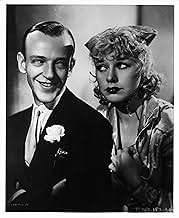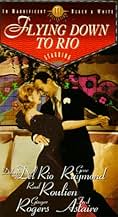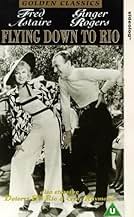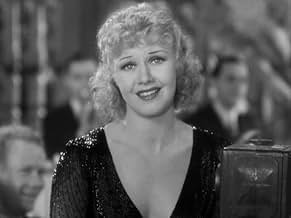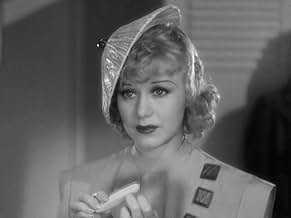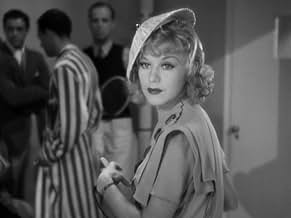NOTE IMDb
6,6/10
4,2 k
MA NOTE
Ajouter une intrigue dans votre langueA bandleader woos a Latin flame who is already engaged to his employer.A bandleader woos a Latin flame who is already engaged to his employer.A bandleader woos a Latin flame who is already engaged to his employer.
- Réalisation
- Scénario
- Casting principal
- Nommé pour 1 Oscar
- 1 victoire et 2 nominations au total
Dolores Del Río
- Belinha De Rezende
- (as Dolores Del Rio)
Luis Alberni
- Rio Casino Manager
- (non crédité)
Bernice Alstock
- Singer
- (non crédité)
Chita Andrews
- Check Girl
- (non crédité)
Avis à la une
Consider this. RKO released "Flying down to Rio" in 1933, when America was in the very depths of the Great Depression. Millions of Americans were out of work and millions more lived in fear of the economic and political realities plaguing the world.
So Hollywood turned out films like this one, escapist fare about rich dilettantes drifting back and forth from Miami to Rio. Indeed, the hero of this little trifle, Gene Raymond, is the scion of a wealthy family who will inherit lots of money, if he gives up fiddling around with song writing and aviation. And the thing is, pictures liked this one worked. The unemployed probably didn't have the ten cents or more it took to get in to see gems like this, but those who did have the money turned out for this kind of picture, gawking at the upper classes in wonder.
"Flying down to Rio," though, is an early talkie and hardly the best example of this kind of romantic comedy. Directed by Thornton Freeland, an early talkie director whose career was largely undistinguished, it has a loose feel about it and does not marry sound and visuals together with any real skill. The pacing is bad, the musical numbers drag on way too long and the film is not the kind of polished production RKO and the rest of Hollywood would start turning out within the next few years.
But "Flying Down to Rio" is remembered today for one thing and one thing only, the first pairing of Fred Astaire and Ginger Rogers, who would become the greatest dance team in movie history. That pairing almost didn't happen, because Ginger's role was originally earmarked for starlet Dorothy Jordan, who wound up catching the eye of Merian C. Cooper, then riding high at RKO after the spectacular success of "King Kong." Jordan became Cooper's girlfriend and quickly his wife and Ginger stepped into her dance shoes and from there into screen immortality. Ironically, Fred and Ginger are not the leads in this film and actually only do one dance number together, but they were good enough to convince the powers that be that new stars had been born, providing those stars could dance their way through their future films.
But aside from that number, there are a couple of other reasons to see this film. The first is top billed star Dolores Del Rio, one of the most beautiful women to ever turn up on the screen. A wealthy socialite from Mexico, she arrived in Hollywood in the silent era and became famous playing a French peasant girl being romanced by two American soldiers in "What Price Glory." Her transition to sound was rocky, though, not because of her voice, but rather what felled many a silent star, her "foreign accent." But it didn't kill her. She returned to Mexico and helped launch its film industry.
Aside from Del Rio, the other things to look for are the Depression era sets. Built to depict hotels and elaborate supper clubs, they are among the most spectacular of the era. And then, finally, there is that other sequence this film is known for, the truly amazing production number featuring the title song, "Flying Down to Rio" in which a bevy of beautiful girls allow themselves to be strapped to the wings of biplanes and flown over Rio as entertainment during the opening of a hotel. While the overwhelming majority of the footage are probably process shots, there appear to be a couple of real life wing walker type shots blended in to give the sequence a realistic feel.
Merian Cooper, then RKO's defacto production boss, was among many other things a pilot himself, an aviation buff and one of the founders of Pan American Airways, the airline that pioneered trans-ocean flight. And even before the famed Pan Am Clippers crossed the Atlantic and the Pacific in the mid-thirties, they'd already established mail and early passenger service to South America with the Sikorsky S-40 nd S-42 flying boats,shown at the end of the film.
In some ways, this film is one big advertisement for the Clippers and for aviation, back when it looked like fun. But then, the real fun was watching Astaire and Rogers in subsequent films proving that in addition to having a good eye for manly stuff like big gorillas and airplanes, Merian C.Cooper was not exactly blind to musical talent, either.
So Hollywood turned out films like this one, escapist fare about rich dilettantes drifting back and forth from Miami to Rio. Indeed, the hero of this little trifle, Gene Raymond, is the scion of a wealthy family who will inherit lots of money, if he gives up fiddling around with song writing and aviation. And the thing is, pictures liked this one worked. The unemployed probably didn't have the ten cents or more it took to get in to see gems like this, but those who did have the money turned out for this kind of picture, gawking at the upper classes in wonder.
"Flying down to Rio," though, is an early talkie and hardly the best example of this kind of romantic comedy. Directed by Thornton Freeland, an early talkie director whose career was largely undistinguished, it has a loose feel about it and does not marry sound and visuals together with any real skill. The pacing is bad, the musical numbers drag on way too long and the film is not the kind of polished production RKO and the rest of Hollywood would start turning out within the next few years.
But "Flying Down to Rio" is remembered today for one thing and one thing only, the first pairing of Fred Astaire and Ginger Rogers, who would become the greatest dance team in movie history. That pairing almost didn't happen, because Ginger's role was originally earmarked for starlet Dorothy Jordan, who wound up catching the eye of Merian C. Cooper, then riding high at RKO after the spectacular success of "King Kong." Jordan became Cooper's girlfriend and quickly his wife and Ginger stepped into her dance shoes and from there into screen immortality. Ironically, Fred and Ginger are not the leads in this film and actually only do one dance number together, but they were good enough to convince the powers that be that new stars had been born, providing those stars could dance their way through their future films.
But aside from that number, there are a couple of other reasons to see this film. The first is top billed star Dolores Del Rio, one of the most beautiful women to ever turn up on the screen. A wealthy socialite from Mexico, she arrived in Hollywood in the silent era and became famous playing a French peasant girl being romanced by two American soldiers in "What Price Glory." Her transition to sound was rocky, though, not because of her voice, but rather what felled many a silent star, her "foreign accent." But it didn't kill her. She returned to Mexico and helped launch its film industry.
Aside from Del Rio, the other things to look for are the Depression era sets. Built to depict hotels and elaborate supper clubs, they are among the most spectacular of the era. And then, finally, there is that other sequence this film is known for, the truly amazing production number featuring the title song, "Flying Down to Rio" in which a bevy of beautiful girls allow themselves to be strapped to the wings of biplanes and flown over Rio as entertainment during the opening of a hotel. While the overwhelming majority of the footage are probably process shots, there appear to be a couple of real life wing walker type shots blended in to give the sequence a realistic feel.
Merian Cooper, then RKO's defacto production boss, was among many other things a pilot himself, an aviation buff and one of the founders of Pan American Airways, the airline that pioneered trans-ocean flight. And even before the famed Pan Am Clippers crossed the Atlantic and the Pacific in the mid-thirties, they'd already established mail and early passenger service to South America with the Sikorsky S-40 nd S-42 flying boats,shown at the end of the film.
In some ways, this film is one big advertisement for the Clippers and for aviation, back when it looked like fun. But then, the real fun was watching Astaire and Rogers in subsequent films proving that in addition to having a good eye for manly stuff like big gorillas and airplanes, Merian C.Cooper was not exactly blind to musical talent, either.
By the time Flying Down to Rio was released in 1933, It was Warner Brothers who had been having the success as far as musicals were concerned.
Ruby Keeler and Dick Powell were the uncrowned King and Queen of song and dance land and in films like 42nd Street, Footlight Parade and Gold Diggers and the later movies Dames and Flirtation Walk they were paving the way for a motion picture genre that would continue in much the same vein for the next twenty years.
With kaleidescope routines expertly directed by Busby Berkeley via overhead cameras, the movie musical was finally taking shape bearing little or no resemblance to earlier dismal efforts like MGM'S Broadway Melody of 1929 or their equally unimpressive Hollywood Review from the same year.
RKO was at the time a struggling studio with huge debts and was on the verge of going bankrupt. However they decided to capitalize on this medium in an effort to pull themselves back into the black.
Flying Down to Rio was in all respects no different to any other of the films they produced at the time and I'm sure this film would have sank into obscurity and be long forgotten had it not been for the movie milestone it boasts.
Fred Astaire and Ginger Rogers were cast as only 3rd and 4th billed performers, to all intents and purposes, the token dance act, a novelty. Neither of them had done much before. Ginger of course was beginning to make a name for herself. She had featured in both the fore-mentioned 42nd Street and Gold Diggers and was slowly working her way out of chorus lines into bit parts and the occasional solo number.
Fred had done less still. Already a well known stage star in America and Britain, he had just one previous film under his belt. A natural dancer of extraordinary talent, Fred was signed on as RKO's secret weapon in their efforts to make the best musicals.
However, no matter how dull the storyline to "Rio" is (and it is believe me) it is soon forgotten when Fred and Ginger perform their first ever screen dance, The Carioca, a musical number with Latin- American tempo complete with stunning costumes, guest singers and the very kaleidoscopic shots of which Busby Berkeley himself would have been proud. It is their only dance together in the film and their actual dancing is given very limited screen-time, but it was enough to cause Astaire/Rogers mania.
Forgive the cliche but the rest is history as they say.
So successful were they that they went on to appear in a further nine films together making them one of the most beloved and cherished screen partnerships ever.
Alone the Astaire/Rogers musicals of the thirties saved the studio from closure and they helped push Warner's, Keeler and Powell into second place, at least as far as musicals were concerned.
Astaire is given further opportunity to shine in two stunning solos which will leave the viewer in no doubt whatsoever why he was the very best at his chosen craft.
Complete with the now famous 'girls-strapped-onto-aeroplane-wings' scene and with the added talents of Delores Del Rio and Gene Raymond adding the romance, It all helps to make an otherwise dull film into a legendary silver screen gem.
Ruby Keeler and Dick Powell were the uncrowned King and Queen of song and dance land and in films like 42nd Street, Footlight Parade and Gold Diggers and the later movies Dames and Flirtation Walk they were paving the way for a motion picture genre that would continue in much the same vein for the next twenty years.
With kaleidescope routines expertly directed by Busby Berkeley via overhead cameras, the movie musical was finally taking shape bearing little or no resemblance to earlier dismal efforts like MGM'S Broadway Melody of 1929 or their equally unimpressive Hollywood Review from the same year.
RKO was at the time a struggling studio with huge debts and was on the verge of going bankrupt. However they decided to capitalize on this medium in an effort to pull themselves back into the black.
Flying Down to Rio was in all respects no different to any other of the films they produced at the time and I'm sure this film would have sank into obscurity and be long forgotten had it not been for the movie milestone it boasts.
Fred Astaire and Ginger Rogers were cast as only 3rd and 4th billed performers, to all intents and purposes, the token dance act, a novelty. Neither of them had done much before. Ginger of course was beginning to make a name for herself. She had featured in both the fore-mentioned 42nd Street and Gold Diggers and was slowly working her way out of chorus lines into bit parts and the occasional solo number.
Fred had done less still. Already a well known stage star in America and Britain, he had just one previous film under his belt. A natural dancer of extraordinary talent, Fred was signed on as RKO's secret weapon in their efforts to make the best musicals.
However, no matter how dull the storyline to "Rio" is (and it is believe me) it is soon forgotten when Fred and Ginger perform their first ever screen dance, The Carioca, a musical number with Latin- American tempo complete with stunning costumes, guest singers and the very kaleidoscopic shots of which Busby Berkeley himself would have been proud. It is their only dance together in the film and their actual dancing is given very limited screen-time, but it was enough to cause Astaire/Rogers mania.
Forgive the cliche but the rest is history as they say.
So successful were they that they went on to appear in a further nine films together making them one of the most beloved and cherished screen partnerships ever.
Alone the Astaire/Rogers musicals of the thirties saved the studio from closure and they helped push Warner's, Keeler and Powell into second place, at least as far as musicals were concerned.
Astaire is given further opportunity to shine in two stunning solos which will leave the viewer in no doubt whatsoever why he was the very best at his chosen craft.
Complete with the now famous 'girls-strapped-onto-aeroplane-wings' scene and with the added talents of Delores Del Rio and Gene Raymond adding the romance, It all helps to make an otherwise dull film into a legendary silver screen gem.
Howard Hughes, oh how we needed you.
From other sources you will have learned that this is pretty sexy stuff in terms of transparent clothes; not a bra on the hundreds of candidates. And the original dirty dancing before it was outlawed, and that crack about what Brazilian women have "below the equator." Also, you will have heard about this being the first Astaire-Rogers pairing.
You may not have heard of one of the most racially respectful scenes I know from the era: a couple land on a supposedly deserted island and the woman is frightened by what she thinks are natives. Turns out one comes out of the woods. He's playing golf and while shirtless (in order to make the joke work) speaks English normally and carries himself like a regular man. Its the reverse joke of what you'd usually see in bugeyed stepinfetchits.
But what I find fascinating is the way sex, romance, money and music are all somehow related to aviation. Our hero, we are told is heir to a fortune if only he would give up his music and planes. But it is plain that he does it because of the women. And by that we know he means sex, only sex. We first see him as he climbs out of his plane, which has a piano stuffed in it. Now think about that a minute.
This is what technology meant in those days: adventure, charm, bodily pleasure. And its what the sort of music we see in films was supposed to imply as well. If you do not see this, let me describe the climax. Scores of scantily clad women are strapped to what looks like a dozen small planes to perform choreographically as best you can when bolted down. Every shot you can take of a woman's body is presented, along with a wingload of errant nipples. I can just imagine the smiles when they thought it up.
There's something else to watch for. This has the most elaborate transitions I believe I have seen for any film. They really are amazingly varied and so copious they are as much a feature as Fred's dancing.
Ted's Evaluation -- 2 of 3: Has some interesting elements.
From other sources you will have learned that this is pretty sexy stuff in terms of transparent clothes; not a bra on the hundreds of candidates. And the original dirty dancing before it was outlawed, and that crack about what Brazilian women have "below the equator." Also, you will have heard about this being the first Astaire-Rogers pairing.
You may not have heard of one of the most racially respectful scenes I know from the era: a couple land on a supposedly deserted island and the woman is frightened by what she thinks are natives. Turns out one comes out of the woods. He's playing golf and while shirtless (in order to make the joke work) speaks English normally and carries himself like a regular man. Its the reverse joke of what you'd usually see in bugeyed stepinfetchits.
But what I find fascinating is the way sex, romance, money and music are all somehow related to aviation. Our hero, we are told is heir to a fortune if only he would give up his music and planes. But it is plain that he does it because of the women. And by that we know he means sex, only sex. We first see him as he climbs out of his plane, which has a piano stuffed in it. Now think about that a minute.
This is what technology meant in those days: adventure, charm, bodily pleasure. And its what the sort of music we see in films was supposed to imply as well. If you do not see this, let me describe the climax. Scores of scantily clad women are strapped to what looks like a dozen small planes to perform choreographically as best you can when bolted down. Every shot you can take of a woman's body is presented, along with a wingload of errant nipples. I can just imagine the smiles when they thought it up.
There's something else to watch for. This has the most elaborate transitions I believe I have seen for any film. They really are amazingly varied and so copious they are as much a feature as Fred's dancing.
Ted's Evaluation -- 2 of 3: Has some interesting elements.
FLYING DOWN TO RIO (RKO Radio, 1933), directed by Thornton Freeland, is a musical showcase for Mexican star Dolores Del Rio playing a Brazilian beauty named Belinia De Rezende, Gene Raymond as Roger Bond, a girl chasing orchestra leader, and Raul Roulien as Julio Rubeiro as Belinia's fiancé and Roger's best friend who complicates matters. By the film's conclusion, the ones who "walked off" with the movie are the supporting players of Ginger Rogers as the band vocalist, and Fred Astaire as the accordionist-dancer, in that order, thus, the beginning of a new screen team, and never again in the persona of sassy Honey Hale and semi-sophisticated Fred Ayres. Yet it's amazing that Astaire and Rogers made such a lasting impression at all in this production, considering they play subordinate roles who supply "comedy relief," and have very little opportunity to act or dance together. Even in the famous, "Carioca," number (which was how they became crowned "The King and Queen of the Carioca"), they get to perform only a few dance steps, but the ensemble of other dancers and singers get most of the footage during its 12 minutes. But even without Astaire and Rogers, or either with one of them along with a different partner, FLYING DOWN TO RIO remains an early musical attempt to capture that South American feel and tango rhythm, predating all those cliché musicals MGM or 20th Century-Fox would distribute in the 1940s, with the addition of Technicolor and/or Xavier Cugat and Carmen Miranda, etc. As for the plot elements, it remains similar to the ones used in subsequent Astaire and Rogers films, but this time the situations of strangers meeting followed by a merry mix-up, belongs to its leading players (Del Rio, Raymond and Roulien). The first half of the movie takes place in Miami, Florida, where the plot development amongst the central characters begin, then shifts to Rio De Janiero, the second largest city in Brazil, where the complications continue and are resolved after 89 minutes of screen time. In between all this comes the singing and dancing to help the plot along.
With the music and lyrics by Gus Kahn, Edward Eliscu and Vincent Youmans, the songs include: "Music Makes Me" (sung by Ginger Rogers in the foreground with Fred Astaire, as one of the members of the band, playing the accordion in the background); "The Carioca" (performed by musicians, danced by numerous Brazilians, sung by Movita and Etta Moten, and danced briefly by Astaire and Rogers); "Orchids in the Moonlight" (sung by Raul Roulien to Dolores Del Rio/reprise, danced by Astaire and Del Rio, with one observer saying to another, "Oh, look, Belinha is dancing our tango with an Americano."); "Music Makes Me" (tap dance solo by Astaire); and "Flying Down to Rio" (sung by Fred Astaire/ danced by girls chained to the wings of the flying airplanes).
Other than some advanced camera techniques used in this production, portions of the movie play like a picture postcard advertisement, mainly during its montage sequences where the camera focuses first from an air-view of famous landmarks, then from the ground view of Rio De Janiero, and flipping over to other scenes of the city from people walking the streets to cars driving down the roads before returning to the storyline.
In the supporting cast are Blanche Frederici as Belinda's old-fashioned Aunt (Tia) Elena; Roy D'Arcy, Maurice Black and Armand Kaliz (The Greeks); Franklin Pangborn (Mr. Hammerstein); Luis Alberni (The Rio Casino Manager); and Eric Blore (Mr. Butterbass), making his first of five performances in an Astaire and Rogers musical. He is an asset to every one of them. It's also interesting to note that Raul Roulien remained somewhat obscure after appearing in this, never to become the Cesar Romero-type of Hollywood. As for the few Hollywood movies to feature him in the early 1930s, this is the only one still in circulation today and possibly his best opportunity on screen.
When Gene Raymond was interviewed about FLYING DOWN TO RIO in the documentary on RKO Radio titled "Hollywood, the Golden Years" (as narrated by Ed Asner back in the late 1980s), he mentioned that he thought that FLYING DOWN TO RIO was going to become the "Bomb of Bombs," but much to his surprise when it made its premiere during the Christmas season at Radio City Music Hall, he noticed while being in New York City that there was a long line of people going around the block waiting to go in and see this movie. One cannot be sure that history would repeat itself again in today's society, but FLYING DOWN TO RIO, in spite of whatever is right or wrong it it, is vintage entertainment at best. Only one debit: acrobats flipping and catching one other, and hanging on the swings under the wings of the flying airplane during the "Flying Down to Rio" number. Not realistic, but it got by. And on the historical side, this is where Astaire and Rogers got their start together on screen, thus, becoming the most popular song and dance team of the movies, never to be topped or equaled by anyone. Now that's something to think about!
FLYING DOWN TO RIO, which was formerly shown on American Movie Classics for many years, is currently presented on Turner Classic Movies. It is also available on video cassette and DVD. Recommended highly to fans of the team and/or musicals from this era. (***1/2)
With the music and lyrics by Gus Kahn, Edward Eliscu and Vincent Youmans, the songs include: "Music Makes Me" (sung by Ginger Rogers in the foreground with Fred Astaire, as one of the members of the band, playing the accordion in the background); "The Carioca" (performed by musicians, danced by numerous Brazilians, sung by Movita and Etta Moten, and danced briefly by Astaire and Rogers); "Orchids in the Moonlight" (sung by Raul Roulien to Dolores Del Rio/reprise, danced by Astaire and Del Rio, with one observer saying to another, "Oh, look, Belinha is dancing our tango with an Americano."); "Music Makes Me" (tap dance solo by Astaire); and "Flying Down to Rio" (sung by Fred Astaire/ danced by girls chained to the wings of the flying airplanes).
Other than some advanced camera techniques used in this production, portions of the movie play like a picture postcard advertisement, mainly during its montage sequences where the camera focuses first from an air-view of famous landmarks, then from the ground view of Rio De Janiero, and flipping over to other scenes of the city from people walking the streets to cars driving down the roads before returning to the storyline.
In the supporting cast are Blanche Frederici as Belinda's old-fashioned Aunt (Tia) Elena; Roy D'Arcy, Maurice Black and Armand Kaliz (The Greeks); Franklin Pangborn (Mr. Hammerstein); Luis Alberni (The Rio Casino Manager); and Eric Blore (Mr. Butterbass), making his first of five performances in an Astaire and Rogers musical. He is an asset to every one of them. It's also interesting to note that Raul Roulien remained somewhat obscure after appearing in this, never to become the Cesar Romero-type of Hollywood. As for the few Hollywood movies to feature him in the early 1930s, this is the only one still in circulation today and possibly his best opportunity on screen.
When Gene Raymond was interviewed about FLYING DOWN TO RIO in the documentary on RKO Radio titled "Hollywood, the Golden Years" (as narrated by Ed Asner back in the late 1980s), he mentioned that he thought that FLYING DOWN TO RIO was going to become the "Bomb of Bombs," but much to his surprise when it made its premiere during the Christmas season at Radio City Music Hall, he noticed while being in New York City that there was a long line of people going around the block waiting to go in and see this movie. One cannot be sure that history would repeat itself again in today's society, but FLYING DOWN TO RIO, in spite of whatever is right or wrong it it, is vintage entertainment at best. Only one debit: acrobats flipping and catching one other, and hanging on the swings under the wings of the flying airplane during the "Flying Down to Rio" number. Not realistic, but it got by. And on the historical side, this is where Astaire and Rogers got their start together on screen, thus, becoming the most popular song and dance team of the movies, never to be topped or equaled by anyone. Now that's something to think about!
FLYING DOWN TO RIO, which was formerly shown on American Movie Classics for many years, is currently presented on Turner Classic Movies. It is also available on video cassette and DVD. Recommended highly to fans of the team and/or musicals from this era. (***1/2)
In Miami, during the presentation of the Yankee Clippers, the wolf band leader and pilot Roger Bond (Gene Raymond) flirts with the guest Belinha de Resende (Dolores Del Rio) and the stringent hotel manager fires them. However, the band is hired for the opening night of the Atlântico Hotel in Rio de Janeiro, and they need to fly to Brazil.
When Roger meets Belinha in the hall of the hotel, he learns that she lost her flight to Rio and he offers a ride for her in his plane. Roger is forced to land in an island and he immediately fixes the mechanical problem in the plane; however, he lies to Belinha and tells that he can not fix the problem just to spend the night alone with her. But Belinha, who is the fiancée of the Brazilian Júlio, resists to his harassment and later she finds another plane to fly to Rio.
Once in Rio, the infatuated Roger meets his friend Júlio without knowing that he is the fiancé of Belinha, and he tells about his love for the woman. When the Yankee Clippers are ready to open the hotel, powerful bankers that are interested to force the bankruptcy of the Atlântico's owner to take the hotel, send the police since he does not have the permit to anticipate the opening day. However, Roger's friend and musician Fred Ayres (Fred Astaire) proposes an airborne show to the guests. Meanwhile, the brokenhearted Roger decides to return to his country and leave Belinha with Júlio.
"Flying Down to Rio" is the debut of the pair Fred and Ginger in minor support roles. The sappy and naive romance has the Mexican Dolores Del Rio performing a Brazilian sassy woman and Gene Raymond in the lead roles. The footages from Rio de Janeiro in the 30's and the airborne show are the best moments of this film. The funniest thing in "Flying Down to Rio" is that there is no Brazilian actor or actress in the cast. My vote is six.
Title (Brazil): "Voando para o Rio" ("Flying to Rio")
When Roger meets Belinha in the hall of the hotel, he learns that she lost her flight to Rio and he offers a ride for her in his plane. Roger is forced to land in an island and he immediately fixes the mechanical problem in the plane; however, he lies to Belinha and tells that he can not fix the problem just to spend the night alone with her. But Belinha, who is the fiancée of the Brazilian Júlio, resists to his harassment and later she finds another plane to fly to Rio.
Once in Rio, the infatuated Roger meets his friend Júlio without knowing that he is the fiancé of Belinha, and he tells about his love for the woman. When the Yankee Clippers are ready to open the hotel, powerful bankers that are interested to force the bankruptcy of the Atlântico's owner to take the hotel, send the police since he does not have the permit to anticipate the opening day. However, Roger's friend and musician Fred Ayres (Fred Astaire) proposes an airborne show to the guests. Meanwhile, the brokenhearted Roger decides to return to his country and leave Belinha with Júlio.
"Flying Down to Rio" is the debut of the pair Fred and Ginger in minor support roles. The sappy and naive romance has the Mexican Dolores Del Rio performing a Brazilian sassy woman and Gene Raymond in the lead roles. The footages from Rio de Janeiro in the 30's and the airborne show are the best moments of this film. The funniest thing in "Flying Down to Rio" is that there is no Brazilian actor or actress in the cast. My vote is six.
Title (Brazil): "Voando para o Rio" ("Flying to Rio")
Le saviez-vous
- AnecdotesStanding outside a bakery shop in Rio, Ginger Rogers asks, "Oh, Freddie, how do you ask for little tarts in Portuguese?" Fred Astaire replies, "Don't heckle me, try the Culbertson System." This pre-Code, double entendre joke would have been funny to Depression-era audiences, for whom bridge was a common pastime. Ely Culbertson was a champion bridge player and worldwide celebrity, who had won several international tournaments by developing a rather aggressive bidding system. He was also notorious for his sexual exploits. His 1940 autobiography was banned in many countries. In the 1930s, the word "tart" was equivalent to "slut" or "whore". Also, in the opening inspection of hotel staff, the boss sees a maid whose shoe heels are oddly beveled and says he will not tolerate that sort of thing. A "round-heeled woman" was 1930s slang for a prostitute, a woman who could tilt easily from standing to being on her back.
- GaffesFrom the height they were flying, most of the "dance" routines of the young women on the plane wings would not be visible to people on the ground.
While true, this observation is not a Goof. The purpose of the event likely was more for advertising or Newsreel value, or even simply "bragging rights".
- Citations
Belinha's Friend: What have these South Americans got below the equator that we haven't?
- ConnexionsFeatured in Hollywood and the Stars: The Fabulous Musicals (1963)
- Bandes originalesMusic Makes Me
(1933) (uncredited)
Music by Vincent Youmans
Lyrics by Gus Kahn and Edward Eliscu
Performed by Ginger Rogers
Meilleurs choix
Connectez-vous pour évaluer et suivre la liste de favoris afin de recevoir des recommandations personnalisées
- How long is Flying Down to Rio?Alimenté par Alexa
Détails
Box-office
- Budget
- 462 000 $US (estimé)
- Durée1 heure 29 minutes
- Couleur
- Rapport de forme
- 1.37 : 1
Contribuer à cette page
Suggérer une modification ou ajouter du contenu manquant


